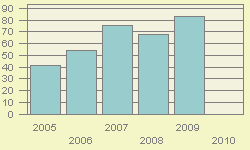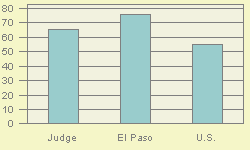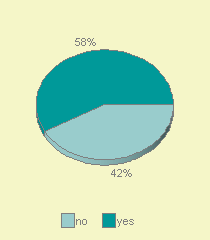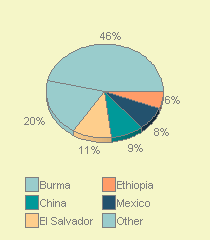Judge William L. Abbott
FY 2005 - 2010, El Paso Immigration Court
Judge Abbott was appointed as an Immigration Judge in December 1995. He was assigned to the Immigration Court in El Paso, Texas, in September 2002, after serving seven years as an Immigration Judge in Eloy, Arizona. He received a Bachelor of Science degree in 1983 from Southwest Texas State University, and a Juris Doctorate from the University of Tulsa School of Law in 1987. After graduating from law school, Judge Abbott joined the Department of Justice through the Attorney General's Honors Program. From 1992 to 1995, Judge Abbott was a trial attorney with the former Immigration and Naturalization Service (INS) in El Paso, Texas. He also served with INS as both sector counsel in El Paso from 1989 to 1992, and as a trial attorney in Houston, Texas, from 1987 to 1988. Judge Abbott served in the U.S. Navy from 1976 to 1982. He is a member of both the Oklahoma and Texas Bars.
Deciding Asylum Cases
Detailed data on Judge Abbott decisions were examined for the period covering fiscal years 2005 through 2010. During this period, Judge Abbott is recorded as deciding 233 asylum claims on their merits. Of these, he granted 80, gave no conditional grants, and denied 153. Converted to percentage terms, Abbott denied 65.7 percent and granted (including conditional grants) 34.3 percent. Figure 1 provides a comparison of Judge Abbott's denial rate fiscal year-by-year over this recent period. (Rates for years with less than 25 decisions are not shown.)
Nationwide Comparisons
Compared to Judge Abbott's denial rate of 65.7 percent, nationally during this same period, immigration court judges denied 55.4 percent of asylum claims. In the El Paso Immigration Court where Judge Abbott was based, judges there denied asylum 75.8 percent of the time. See Figure 2.
Judge Abbott can also be ranked compared to each of the 253 individual immigration judges serving during this period who rendered at least one hundred decisions in a city's immigration court. If judges were ranked from 1 to 253 - where 1 represented the highest denial percent and 253 represented the lowest - Judge Abbott here receives a rank of 113. That is 112 judges denied asylum at higher rates, and 140 denied asylum at the same rate or less often. Ranks are tallied separately for each immigration court. Should a judge serve on more than one court during this period, separate ranks would be assigned in any court that the judge rendered at least 100 asylum decisions in.
Why Do Denial Rates Vary Among Judges?
Denial rates reflect in part the differing composition of cases assigned to different immigration judges. For example, being represented in court and the nationality of the asylum seeker appear to often impact decision outcome. Decisions also appear to reflect in part the personal perspective that the judge brings to the bench.
Representation
If an asylum seeker is not represented by an attorney, almost all (88%) of them are denied asylum. In contrast, a significantly higher proportion of represented asylum seekers are successful. In the case of Judge Abbott, 42.1% were not represented by an attorney. See Figure 3. For the nation as a whole, about 11% of asylum seekers are not represented.
Nationality
Asylum seekers are a diverse group. Over one hundred different nationalities had at least one hundred individuals claiming asylum decided during this period. As might be expected, immigration courts located in different parts of the country tend to have proportionately larger shares from some countries than from others. And, given the required legal grounds for a successful asylum claim, asylum seekers from some nations tend to be more successful than others.
For Judge Abbott, the largest group of asylum seekers appearing before him came from Burma. Individuals from this nation made up 19.7 % of his caseload. Other nationalities in descending order of frequency appearing before Judge Abbott were: El Salvador (10.7 %), China (9%), Mexico (8.2%), Ethiopia (6%). See Figure 4.
In the nation as a whole during this same period, major nationalities of asylum seekers, in descending order of frequency, were China (21.7%), Haiti (9.9%), Colombia (7.1%), El Salvador (5.1%), Guatemala (4.8%), Indonesia (3.6%), India (2.6%), Venezuela (2.5%), Albania (2.5%), Ethiopia (1.9%), Honduras (1.8%), Guinea (1.6%), Mexico (1.5%).




